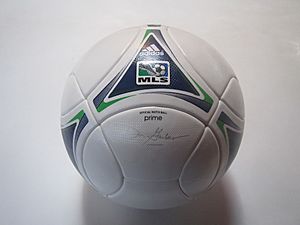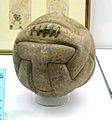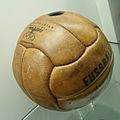Ball (association football) facts for kids
A football (also called a soccer ball) is the special ball used in the sport of association football. The name of the ball depends on whether the sport is called "football" or "soccer" where you live. The rules for the ball's round shape, size, weight, and what it's made of are set by Law 2 of the Laws of the Game. These rules are kept by the International Football Association Board. Bigger football organizations like FIFA have even stricter rules for balls used in their big tournaments.
Long ago, footballs were made from things like animal bladders or stomachs. These fell apart easily if kicked too much! Things got much better in the 19th century when rubber was invented and people learned how to make it stronger (this was called vulcanization, discovered by Charles Goodyear). The classic 32-panel ball design we often think of was created in 1962 by Eigil Nielsen. Later, in 2007, new designs with 24 or 42 panels came out, making the balls perform even better.
The famous black-and-white pattern, like a soccer ball made of many shapes, became popular with the Adidas Telstar ball. This design is now a symbol of the sport. Today, there are many different kinds of footballs, with various looks and features.
Contents
How Footballs Are Made
Ball Construction
Modern footballs are much more advanced than old ones. Most today have 12 five-sided shapes (pentagons) and 20 six-sided shapes (hexagons). These are put together to make a round shape, like a truncated icosahedron. Some very good balls use slightly different shapes to make them even rounder.
Inside the football is a special bag called a bladder, usually made of latex or butyl rubber. This bladder holds the air that makes the ball bouncy. The outside of the ball is made from materials like leather, fake leather, polyurethane, or PVC. The surface can have textures or patterns to help players control the ball better. The different panels are either sewn together by machine or by hand, or they are glued together using heat (thermo-bonded). To stop the ball from soaking up water, it might have a special coating or its seams might be glued.
Size and Weight
For official games, a standard "Size 5" football must be about 68 to 70 centimeters (27 to 28 inches) around. It should weigh between 410 and 450 grams (14 to 16 ounces). The ball needs to be inflated to a certain air pressure, usually between 0.6 and 1.1 bar (9 to 16 psi) at sea level.
Smaller balls are also made, like Sizes 1, 3, and 4. These are great for younger players or for practicing skills.
Different Types of Footballs
There are many kinds of footballs, each designed for different games and playing surfaces.
- Professional Match Balls are the best quality balls. Top teams and players use them in big games. They are approved by FIFA and are designed to be super accurate, fast, and easy to control. They hold air well and don't soak up much water. These balls work on real grass and artificial turf. They are the most expensive.
- Matchday Balls are also high-quality balls, good for all playing surfaces. Their outer layer is usually leather or a strong synthetic material, and they are often water-resistant. They meet official size, weight, and texture rules and are suitable for all ages and skill levels.
- Training Balls are tough and durable, made for everyday practice. They are built to last on all kinds of playing surfaces and are used by players of any level. Training balls are usually the cheapest option.
- Turf Balls are made especially for artificial grass fields. They are strong and affordable, but they might bounce differently on real grass.
- Indoor Soccer Balls are the same size as outdoor balls but are designed to bounce less. This helps players control the ball better on smaller indoor courts. The outer cover is very strong to handle hitting walls and hard floors.
- Futsal Balls are different because their inside is filled with foam, making them heavier and less bouncy. This is good for the hard surfaces used in futsal. Futsal balls are also smaller than regular footballs.
Who Makes Footballs?
Many companies around the world make footballs. In the past, balls were made by local businesses where games were played. Today, a large number of footballs (about 55%) are made in Sialkot, Pakistan. China and India are also big producers.
After some problems with balls in the 1962 FIFA World Cup, Adidas created a new ball called the Adidas Santiago. Because of this, Adidas won the contract to supply balls for all official FIFA and UEFA games. They have held this contract since the 1970s and also supply balls for the Olympic Games. Adidas also makes the ball for the UEFA Champions League, which is called the Adidas Finale.
FIFA World Cup Balls
In the early days of the FIFA World Cup, the host country usually provided the match balls from local makers. Sometimes, different balls were even used in the same tournament or even in one game! Over time, FIFA started to have more control over which ball was used. Since the 1970 World Cup, Adidas has supplied the official match balls for every tournament.
League Balls
Many different football leagues around the world use specific balls from various brands. For example, the Premier League in England uses Nike Flight balls, while the Bundesliga in Germany uses Derbystar Brillant APS balls. These balls are chosen to meet the high standards of professional play.
Images for kids
-
A leather ball used in the football tournament at the 1936 Summer Olympics
-
An Adidas Torfabrik football used in the Bundesliga in 2011
See also
In Spanish: Balón de fútbol para niños





